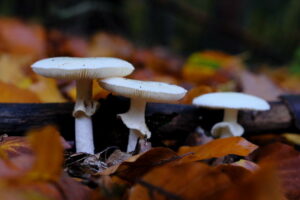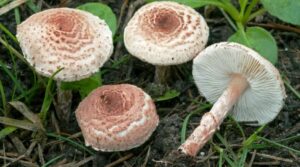Notable Elements
Critical Awareness: Emphasizes the importance of being knowledgeable about the dangers of wild mushroom foraging due to the presence of many toxic species.
Identification is Key: Highlights the necessity of correctly identifying mushrooms, as many deadly varieties closely resemble edible ones.
Top 10 Dangerous Mushrooms: Lists and describes ten of the most lethal mushrooms found globally, including Death Cap, Destroying Angel, and Fly Agaric, focusing on their appearance, habitats, and the severe health implications of ingestion.
Symptoms of Poisoning: Details the symptoms associated with consuming these toxic mushrooms, such as gastrointestinal distress, liver and kidney failure, and potentially fatal outcomes.
Educational Approach: Stresses the need for education and consultation with experts in mycology for safe mushroom foraging.
Avoidance Strategies: Provides practical tips for avoiding dangerous mushrooms, including thorough identification, attending expert-led workshops, and starting with easily identifiable species.
Safety First: Advises against consuming wild mushrooms unless absolutely certain of their safety and suggests sticking to commercially available varieties.
Health Risks Highlighted: Underlines the serious health risks, including organ failure and death, associated with consuming toxic mushrooms.
Expert Consultation: Recommends consulting field guides, mycologists, and participating in local foraging groups for reliable information.
Foraging with Caution: Encourages cautious and responsible mushroom foraging, emphasizing the mantra “when in doubt, throw it out” to ensure safety.
Introduction
Mushrooms have been known for their unique flavors, medicinal properties, and intriguing appearances for centuries. However, foraging for wild mushrooms requires extensive knowledge and caution, as many species can be deadly if ingested.
10 Deadly Mushrooms
Today, we will explore ten mushrooms notorious for their fatal consequences if consumed. Delving into what happens when ingested, we hope to emphasize the importance of expert guidance for mushroom foraging.
Death Cap (Amanita phalloides):
One of the most toxic mushrooms in the world, the Death Cap, can cause severe liver damage and eventually lead to death. Symptoms may take several days to appear after ingestion and include stomach pain, vomiting, liver failure, and even coma. Consuming any unidentified fungus has an alarming mortality rate, so it is crucial never to consume it.

It may be found all over the world, including North America, Europe, and Asia. It often grows near oak, chestnut, and beech trees, primarily in woodlands.
Destroying Angel (Amanita bisporigera):
Resembling your common button mushroom— this deceptively beautiful fungus contains deadly toxins. Symptoms do not manifest until several hours after consumption and include severe abdominal pain, vomiting, and diarrhea. Destroying Angel mushrooms can cause liver and kidney failure, often leading to death if not treated promptly.
It is found in temperate regions of North America and Europe, growing in coniferous forests, mixed woodlands, and grassy areas.
Deadly Webcap (Cortinarius rubellus):
Found in coniferous forests of Europe, the Deadly Webcap contains a toxin called orellanine. Ingesting this mushroom results in kidney damage that frequently requires dialysis and, in severe cases, can lead to renal failure. Symptoms include gastrointestinal distress and prolonged flu-like symptoms.
Sweden, the UK, Germany, and France all have it, also reported in North America, particularly in the Pacific Northwest region of the United States. It thrives in coniferous forests, typically associating with trees like pine and spruce.
Fool’s Mushroom (Amanita verna):
Often mistaken for a common edible mushroom, the Fool’s Mushroom contains a lethal toxin that affects the liver and kidneys. Symptoms may not appear for 6-48 hours after ingestion and typically include severe vomiting, diarrhea, and abdominal pain. Left untreated, it can lead to liver and kidney failure, proving to be fatal.
It is widespread in Europe but also seen in North America and Asia.
Panther Cap (Amanita pantherina):
The Panther Cap is often confused with hallucinogenic mushrooms due to its psychoactive properties. However, consuming this fungus can lead to severe poisoning characterized by gastrointestinal distress, hallucinations, and delirium. In severe cases, individuals may experience seizures and succumb to organ failure.
It prefers deciduous and mixed forests in various parts of North America, Europe, and Asia.
Deadly Galerina (Galerina marginata):
This small and inconspicuous mushroom in North America contains the liver-damaging toxin amatoxin. Consuming even a tiny amount can result in severe gastrointestinal distress, followed by liver and kidney failure. Symptoms often manifest after 6-24 hours and include vomiting, diarrhea, and abdominal pain.
Deadly Galerina is a widely distributed species located in various parts of the world, including North America, Europe, and Asia.
Autumn Skullcap (Galerina marginata):
Commonly mistaken for edible mushrooms, the Autumn Skullcap contains the same deadly toxin as the Deadly Galerina. Symptoms are similar, with abdominal pain, vomiting, and jaundice being the most prominent. Without immediate medical intervention, liver failure is inevitable and can be fatal.
It has a widespread distribution in North America and Europe.
Fly Agaric (Amanita muscaria):
The Fly Agaric mushroom is iconic for its red cap dotted with white specks. Though it is not as lethal as some others on this list, it contains dangerous toxins that can cause hallucinations, gastrointestinal distress, severe cases, seizures, and coma. Consuming large quantities of Fly Agaric can be life-threatening, particularly for children or individuals with compromised health.
This iconic mushroom is widespread in Europe, Asia, North America, and Australia.
Deadly Dapperling (Lepiota brunneoincarnata):
Often mistaken for edible puffball mushrooms, the Deadly Dapperling contains amatoxins that are highly toxic to the liver. Symptoms include severe gastrointestinal distress, jaundice, and significant liver damage. Delaying medical intervention in cases of ingestion can lead to liver failure, with a fatality rate of up to 30%.

Native to Europe, found in countries like France, Germany, and the UK. Also, reported in North America, specifically in parts of the United States like California, Oregon, and Washington. Grassy areas, meadows, lawns, and woodland edges are excellent habitats for this species.
Red-staining Fibrecap (Inocybe erubescens):
Though not as infamous as some of the mushrooms mentioned before, Inocybe erubescens pose a significant health threat. Ingesting this mushroom can lead to gastrointestinal discomfort, muscle pain, and cramps. In severe cases, it may cause rhabdomyolysis, a condition leading to the breakdown of muscle tissue and potential kidney failure.
This mushroom is common in Europe but also grows in North America.
How to avoid deadly mushroom species?
Knowing how to identify deadly mushroom species and being cautious while foraging are essential to avoiding deadly mushroom species. Here are a few tips to help you avoid dangerous mushrooms:
- Educate yourself: Learn about the deadly mushroom species in your area. Familiarize with their distinctive characteristics, habitats, and toxic effects.
- Consult field guides and experts: Invest in reliable field guides or consult mycologists or experienced mushroom foragers who can guide local mushroom species and their identification.
- Attend workshops or forays: Participate in guided mushroom forays or workshops organized by local mycological societies or experts. These events provide hands-on learning and allow you to interact with experienced foragers.
- Learn to recognize toxic mushrooms: Focus on learning to identify the deadly mushrooms in your region. Key features to look out for include distinctive colors, shapes, and patterns on the caps, gills, and stems.
- Double-check identification: When in doubt, never consume or even touch a mushroom that you are unsure of. Many deadly poisonous species have non-lethal lookalikes, so double-checking is crucial.
- Start with easily identifiable species: As a beginner, stick to foraging for mushrooms that are easier to identify and have no toxic lookalikes. For example, it’s less risky with easily recognizable edible species like morel or oyster mushrooms.
- Avoid collecting damaged or decaying mushrooms: Toxic mushrooms may sometimes resemble safe ones when decomposed or damaged. Always gather fresh, undamaged mushrooms.
- Don’t rely solely on visual cues: Visual cues like color or shape are useful, but should not be the sole basis for identification. Consider other features such as smell, habitat, and spore print color.
- Stay away from unknown species: A general guideline is to bypass eating any wild mushroom unless you are 100% sure of its identification, even if it looks similar to an edible species.
- Practice gradual learning: Gradually expand your knowledge and skills as you gain experience. Start by confidently identifying a handful of mushrooms before moving on to a more challenging species.
Remember, the safest approach is to be cautious and consult experts.
Also Read : Exploring Different Strains of Magic Mushrooms for Wellness
Conclusion:
Mushrooms, with their diverse forms and captivating characteristics, can be a source of awe and intrigue. However, foraging for wild mushrooms carries immense risks, as numerous deadly species are lurking amidst innocent-looking counterparts.
The mushrooms discussed above serve as a sobering reminder of the utmost importance of caution and expert guidance when exploring the world of mycology.
Foraging for wild mushrooms should only be done by experienced individuals who possess in-depth knowledge about the different species, their identification, and their toxicity. A single misidentification or careless decision can lead to irreversible health consequences or even death.
So, when in doubt, it is best to rely on commercially available and safe-to-eat mushrooms. The slogan “when in doubt, throw it out” holds to safeguard your health and well-being.

Hi! I’m Jacob Hawthorne, a passionate medical student dedicated to exploring the fascinating world of psychedelics, particularly magic mushrooms (commonly known as shrooms). With a deep interest in their therapeutic potential and profound effects on the human mind, I aim to provide accurate and evidence-based information about shrooms in the Canadian context.

